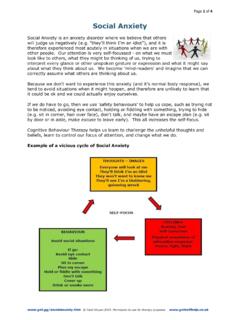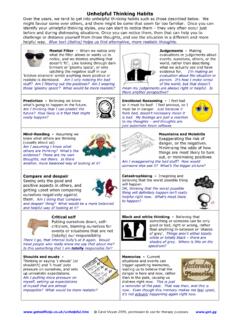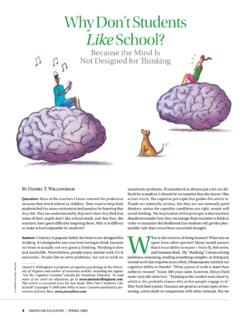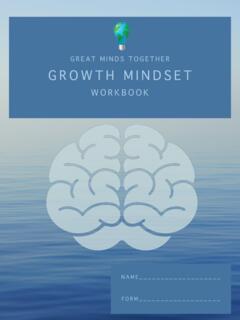Transcription of Human Error and Commercial Aviation Accidents: A ...
1 Human Error and Commercial Aviation Accidents: A Comprehensive, Fine-Grained Analysis Using HFACSS cott ShappellClemson University Clemson, SC 29634 Cristy DetwilerKali HolcombCarla HackworthFederal Aviation AdministrationCivil Aerospace Medical InstituteOklahoma City, OK 73125 Albert BoquetEmbry-Riddle Aeronautical UniversityDaytona Beach, FL 32114 Douglas WiegmannMayo ClinicRochester, MN 55905 July 2006 Final ReportDOT/FAA/AM-06/18 Office of Aerospace MedicineWashington, DC 20591 NOTICEThis document is disseminated under the sponsorship of the Department of Transportation in the interest of information exchange. The United States Government assumes no liability for the contents publication and all Office of Aerospace Medicine technical reports are available in full-text from the Civil Aerospace Medical Institute s publications Web site: Report Documentation Page 1.
2 Report No. 2. Government Accession No. 3. Recipient's Catalog No. DOT/FAA/AM-06/18 4. Title and Subtitle 5. Report Date July 2006 Human Error and Commercial Aviation Accidents: A Comprehensive, Fine-Grained Analysis Using HFACS 6. Performing Organization Code 7. Author(s) 8. Performing Organization Report No. Shappell SA,1 Detwiler CA,2 Holcomb KA,2 Hackworth CA,2 Boquet AJ,3 Wiegmann DA49. Performing Organization Name and Address 10. Work Unit No. (TRAIS) 1 Clemson University,Clemson, South Carolina 29634 2 FAA Civil Aerospace Medical Institute, Oklahoma City, OK 731253 Embry-Riddle Aeronautical University, Daytona Beach, FL 32114 4 Mayo Clinic; Rochester, MN 5590511. Contract or Grant No. 12. Sponsoring Agency name and Address 13. Type of Report and Period Covered Office of Aerospace Medicine federal Aviation Administration 800 Independence Ave.
3 , S. W. Washington, 20591 14. Sponsoring Agency Code 15. Supplemental Notes Work was accomplished under approved subtask AM-B-05-HRR-521. 16. Abstract The Human Factors Analysis and Classification System (HFACS) is a theoretically based tool for investigating and analyzing Human Error associated with accidents and incidents. Previous research has shown that HFACS can be reliably used to identify general trends in the Human factors associated with military and general Aviation accidents. The aim of this study was to extend previous examinations of Aviation accidents to include specific aircrew, environmental, supervisory, and organizational factors associated with 14 CFR Part 121 (Air Carrier) and 14 CFR Part 135 (Commuter) accidents using HFACS. The majority of causal factors were attributed to the aircrew and the environment, with decidedly fewer associated with supervisory and organizational causes.
4 Comparisons were made between HFACS categories and traditional situational variables such as weather, lighting, and geographic region. Recommendations were made based on the HFACS findings presented. 17. Key Words 18. Distribution Statement Human Error , HFACS, Aviation Accidents, Commercial AviationDocument is available to the public through the Defense Technical Information Center, Ft. Belvior, VA 22060; and the National Technical Information Service, Springfield, VA 2216119. Security Classif. (of this report) 20. Security Classif. (of this page) 21. No. of Pages 22. Price Unclassified Unclassified 22 Form DOT F (8-72) Reproduction of completed page authorized 1 Human Error and Commercial Aviation aCCidEnts: a ComprEHEnsivE, FinE-GrainEd analysis usinG HFaCs Flying is not inherently dangerous, but to an even greater extent than the sea, it is terribly unforgiving.
5 Captain A. G. Lumplugh, British Aviation Insurance GroupINTRODUCTION Since Silas Christofferson first carried passengers on his hydroplane between San Francisco and Oakland harbors in 1913, engineers and psychologists have endeavored to improve the safety of passenger and cargo flight. What began as an industry fraught with adversity and at times tragedy has emerged as arguably one of the safest modes of transportation , no one can question the tremendous strides that have been made since those first passenger flights nearly a century ago. However, while commercial1 avia-tion accident rates have reached unprecedented levels of safety, little, if any, improvement has been realized over the last decade for either the air carrier or commuter/air taxi industry (Figure 1). Indeed, some have even sug-gested that the current accident rate is as good as it gets or is it?
6 The challenge for the federal Aviation administra -tion (FAA) and other civil Aviation safety organizations is to improve an already very safe industry. The question is where to start when most of the low hanging fruit ( , improved powerplant and airframe technology, advanced avionics, and the introduction of automation) have been picked. Although percentages vary, most would agree that somewhere between 60-80% of Aviation accidents are due, at least in part, to Human Error (Shappell & Wieg-mann, 1996). That being said, it may be surprising that with few exceptions ( , Billings & Reynard, 1984; Gaur, 2005; Li, Baker, Grabowski, & Rebok, 2001; Shappell & Wiegmann, 2003a, 2003b; Wiegmann & Shappell, 2003) most studies to date have focused on situational factors or pilot demographics, rather than the underlying Human Error causes of accidents.
7 While no one disagrees that factors like weather, lighting ( , day versus night), and terrain contribute to accidents, pilots have little, if any, control over them. Likewise, little can be done to affect one s gender, age, occupation, 1 The FAA distinguishes between two types of Commercial operations: those occurring under 14 CFR Part 121 Air Carrier Operations and those occurring under CFR Part 135 - Commuter/air taxi even flight experience, as flight hours alone are not the sole determinant of a safe pilot. Judging from current accident rates, situational and pilot demographic data alone have provided little in the way of preventing accidents, apart from identifying target populations for the dissemination of safety information. This is not to say that these variables are unimportant, nor would anyone argue that they do not influence Aviation safety.
8 However, given the multi-factorial nature of accidents (Baker, 1995), it may make more sense to examine these variables within the context of what we know about Human Error and accident causation. Perhaps then we might be able to affect Human Error and reduce Aviation accidents beyond current levels. The problem is that, unlike situational and demo-graphic variables that are tangible and well-defined ( , instrument meteorological conditions and visual meteoro-logical conditions), Human Error is much more complex, making it difficult to apply any sort of taxonomy that is both easily understood and universally accepted. However, that may have changed with the development of the Hu-man Factors Analysis and Classification System (HFACS) in the mid-1990s. In fact, since the Navy/Marine Corps fielded the original version in 1997, HFACS has been used to reliably investigate and classify Human Error in a variety of high-risk settings including civilian avia-tion (Gaur, 2005; Shappell & Wiegmann, 2003a, 2003b, 2004; Wiegmann & Shappell, 2001a, 2003).
9 Figure 1. Air carrier and commuter/air taxi accident rates since 1985 (Source: NTSB).00 . 511 . 522 . 533 . 544 . 58 58 68 78 88 99 09 19 29 39 49 59 69 79 89 9' 0 0' 0 1' 0 2' 0 3' 0 4 Accidents per 100,000 Flight HoursYearFigure 1. 135 & 121 Accident Rate by yearCommuterAir Carrier2 HFACSIt is generally accepted that (Wiegmann & Shappell, 2001a, 2003) Aviation accidents are typically the result of a chain of events that often culminate with the unsafe acts of operators (aircrew). The Aviation industry is not alone in this belief, as the safety community has embraced a sequential theory of accident investigation since Heinrich first published his axioms of industrial safety in 1931 (Heinrich, Peterson, & Roos, 1931). However, it was not until Reason published his Swiss cheese model of Human Error in 1990 that the Aviation community truly began to examine Human Error in a systematic upon Reason s (1990) concept of latent and active failures, HFACS describes Human Error at each of four levels: 1) the unsafe acts of operators ( , aircrew, maintainers, air traffic controllers), 2) preconditions for unsafe acts, 3) unsafe supervision ( , middle-manage-ment), and 4) organizational influences (Figure 2).
10 A brief description of each causal category is provided to familiarize the Acts of OperatorsThe unsafe acts of operators (aircrew) can be loosely classified into one of two categories: errors and viola-tions (Reason, 1990). While both are common within 2 A complete description of all 19 HFACS causal categories is available elsewhere (see Wiegmann & Shappell, 2003).most settings, they differ markedly when the rules and regulations of an organization are considered. That is, while errors represent authorized behavior that fails to meet the desired outcome, violations refer to the willful disregard of the rules and regulations. It is within these two overarching categories that HFACS describes three types of errors (decision, skill-based, and perceptual) and two types of violations (routine and exceptional).
















